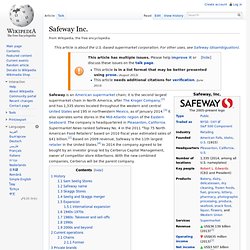

Stop & Shop/Giant-Landover. Stop & Shop/Giant-Landover is a combined supermarket chain that is owned by the American subsidiary of the Dutch retailer Ahold.

The company took its current form in 2004, after Ahold decided to combine the operations of its New England-based Stop & Shop chain with its Delmarva-based Giant Food chain to create the largest supermarket company in the Mid-Atlantic States. Previously Giant's headquarters were in Landover, Maryland while Stop & Shop kept their headquarters in Quincy, Massachusetts. History[edit] In early 2004, Royal Ahold made the move to end local management at Giant Food's headquarters in Landover, Maryland. Ahold also named Stop & Shop's chief executive Marc E. In March 2005, Giant-Stop & Shop announced that they had entered into a collaboration with Staples, Inc. for a Staples branded store-within-store section for all 550 Stop & Shop Supermarkets and Giant Food supermarkets in the Northeast region.
External links[edit] Ahold. Ahold or Koninklijke Ahold N.V. is a Dutch international retailer based in Amsterdam, Netherlands.

Ahold is an AEX-listed company on NYSE Euronext Amsterdam. History[edit] Kroger. Kroger headquarters The Kroger Company is an American retailer founded by Bernard Kroger in 1883 in Cincinnati, Ohio.

By revenue, it is the country's largest supermarket chain,[2] second-largest general retailer (after Walmart),[2] and twenty-third largest company.[3] Kroger is also the fifth largest retailer in the world.[4] As of February 2013[update], Kroger operates, either directly or through its subsidiaries, 2,424 stores.[5] Kroger's headquarters are in downtown Cincinnati.[5] It maintains markets in 31 states,[6] with store formats that include supermarkets, superstores, department stores, convenience stores, and mall jewelry stores. Kroger-branded grocery stores are located throughout the Midwestern and Southern United States.
Safeway Inc. Safeway is an American supermarket chain; it is the second largest supermarket chain in North America, after The Kroger Company,[2] and has 1,335 stores located throughout the western and central United States and 195 in northwestern Mexico, as of January 2014.[3] It also operates some stores in the Mid-Atlantic region of the Eastern Seaboard.

The company is headquartered in Pleasanton, California. Supermarket News ranked Safeway No. 4 in the 2011 "Top 75 North American Food Retailers" based on 2010 fiscal year estimated sales of $41 billion.[2] Based on 2009 revenue, Safeway is the 11th largest retailer in the United States.[4] In 2014 the company agreed to be bought by an investor group led by Cerberus Capital Management, owner of competitor store Albertsons. NSD - National Shrink Database. Grocery stores not so good at composting - The Market Report. Deep in the underbelly of Georgetown’s sparkling, LEED-certified Safeway, beneath the special white roof that reduces the need for AC and the LED lighting and ozone-friendly refrigerants, spokesperson Craig Muckle leads the way to a concrete warehouse.

He’s about to reveal the heart of the store’s composting efforts: the compost pile. “This might be slightly underwhelming,” he warns. Indeed, the compost pile of the District’s first LEED-certified grocery store cower in the corner of the loud, cavernous warehouse, taking up no more than a few square feet. Composting is the buzzy environmental concept that has yet to blossom in grocery stores. With composting and other innovative waste-reduction programs, retailers are finding new ways to divert trash away from landfills. A few months ago, two Albertsons stores in Santa Barbara, Calif., accomplished something exciting for the food retailing industry, becoming the first supermarkets in the nation to achieve “Zero Waste” classification.

More than 95% of all waste generated by the stores is now either recycled, reused or composted, thus diverting more than 2 million pounds of waste from landfills annually, including 808,000 pounds of cardboard, 27,500 pounds of plastic and almost 2,700 pounds of paper. Of ... Why Register for FREE? Registering for content on Supermarket News will give you INSTANT access to invaluable articles and media content that industry professionals rely on. You will have access to our special reports, feature articles, and industry analysis. Click here to read the FAQ page if you have any questions (opens in a new window) Attention Paid Print Subscribers: While you have already been granted free access to SN we ask that you register now. Already registered? Universal Product Code.
Composition[edit] Each UPC-A barcode consists of a scannable strip of black bars and white spaces, above a sequence of 12 numerical digits.

No letters, characters, or other content of any kind may appear on a standard UPC-A barcode. The digits and bars maintain a one-to-one correspondence - in other words, there is only one way to represent each 12-digit number visually, and there is only one way to represent each visual barcode numerically. The scannable area of every UPC-A barcode follows the pattern SLLLLLLMRRRRRRE, where the S (start), M (middle), and E (end) guard bars are represented exactly the same on every UPC and the L (left) and R (right) sections collectively represent the 12 numerical digits that make each UPC unique.
The first digit L indicates a particular number system to be used by the following digits.